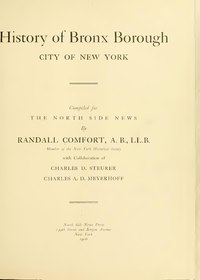The following is a timeline of the history of the borough of the Bronx in New York City, New York, United States.
Contents
- Prior to the 19th century
- 19th century
- 1800s-1880s
- 1890s
- 20th century
- 1900s
- 1910s
- 1920s
- 1930s
- 1940s
- 1950s
- 1960s
- 1970s
- 1980s
- 1990s
- 21st century
- 2000s
- 2010s
- 2020s
- See also
- References
- Bibliography
- Published in 20th century
- Published in 21st century
- External links
| History of New York City |
|---|
 |
| Lenape and New Netherland, to 1664 New Amsterdam British and Revolution, 1665–1783 Federal and early American, 1784–1854 Tammany and Consolidation, 1855–1897 (Civil War, 1861–1865) Early 20th century, 1898–1945 Post–World War II, 1946–1977 Modern and post-9/11, 1978–present |
| See also |
| Timelines: New York City • Manhattan • Bronx • Brooklyn • Queens • Staten Island Transportation Category |



